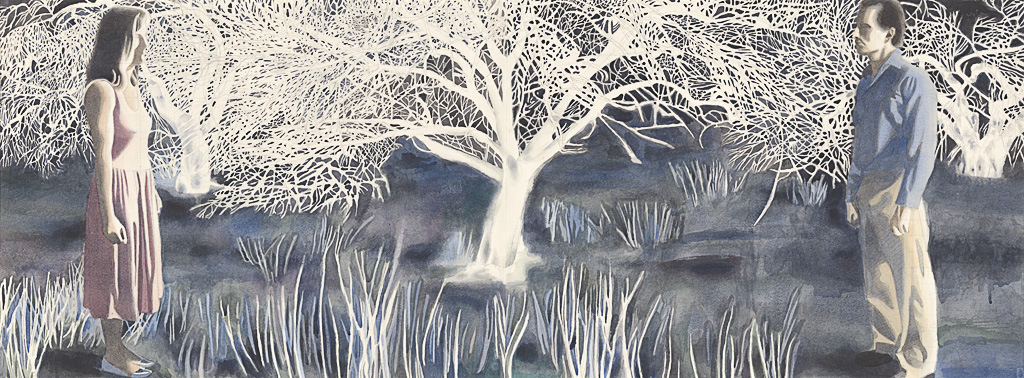The figures are half submerged in shadows. The landscape features lush trees, a distant shepherd and flock, a water fountain, a luxuriously clad musician and friend and two naked goddesses (who may or may not be visible to the self-absorbed gentlemen). It is a tantalizing picture of love, music, nature and inspiration. This poetic painting, so moody and mysterious, suggests mythology without illustrating a specific story.
Nature imagery and love poem combine in Renaissance art in an “enigmatic pastoral” genre often referred to as poesia. This blog looks at two more recent examples of poesia to demonstrate the adaptability of this remarkable genre.
In modern times, the painters Manet and Munch revolutionize the lyrical mood of these pastoral images by introducing troubling contemporary elements, suggesting strongly the need for love, but implying that love is imperfect or imperfectly fulfilled.
In the image above, Munch’s dancers move from the youth on the left to the lonely widow on the right in a symbolic cycle of life. The moonlit landscape, a meadow that overlooks a beach, casts an eerie spell on the figures who move as if in a trance through their allotted roles. Munch turns poesia into an allegory, where love is seen as a kind of obligatory social expectation and those who fall outside the norm of it find themselves unhappily cast out.
The Canadian artist Robert Pope (1956-1992) added his own take on this ever-changing genre. The above image shows a landscape that both separates and connects figures who stand as if awaiting the signal for a duel. The artist turns natural elements like the apple tree into a mandala-like signifier that must mediate the unspeakable feelings of his spellbound lovers. The landscape is charged with energy and significance, but the meaning is ambiguous. Like the Giorgione, the image is moody and mysterious. Like Munch, the image of love unfolding suggests both anxiety and compulsion.
In Orchard, there is a mythic allusion to Adam and Eve and the forbidden tree of knowledge. Like other peosia images, Robert’s Orchard departs from the mythic source to tell its own story. Robert was inspired by Elizabeth Smart’s novel By Grand Central Station I Sat Down and Wept (1945), the story of an unhappy love affair between a poet and a married novelist. The figures in the painting are poets, much as the figures in the Giorgione’s poesia are musicians. By creating a series about poets who break a taboo by falling in love, Robert returns to Giorgione’s theme of artistic inspiration, but complicates it by suggesting that the practitioners of art, poetry and love enter a dreamscape that is dangerous and possibly forbidden.
The Garden of Eden is ultimately a story of acquiring knowledge and self-awareness, a knowledge that makes people human, but also separates them from nature. This separation is symbolized by the expulsion from the garden. Poets and artists see the world differently. Instead of accepting exile and taking pride in our separation from nature, poets dare to dream of reuniting with nature, of re-entering the garden. Robert’s Orchard suggests that the landscape, so central to the poesia genre, may not symbolize an idyllic safe-haven for poetic inspiration, but rather a kind embattled almost unrecognized zone to sneak into at night at the user’s peril.
Poesia is a genre still vibrantly alive in contemporary art. The license these poetic images take with mythology allow them a flexibility to adapt to new circumstances and changing attitudes. At its best, the genre is mysterious and paradoxical, exploring both social and rebellious elements in processes of love, art and creativity.
A retrospective of Robert Pope’s work is currently on view at the Art Gallery of Nova Scotia in Halifax and will be on view until December 9, 2012. More info on Pope’s work and his legacy can be found at the Robert Pope Foundation website.


